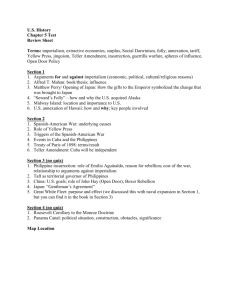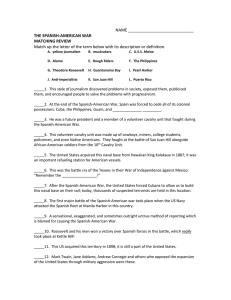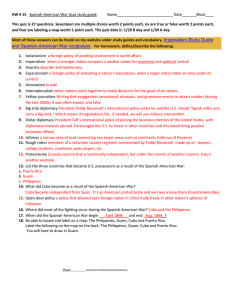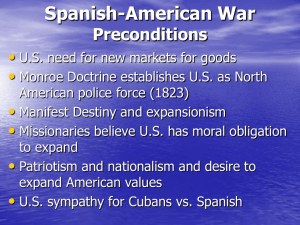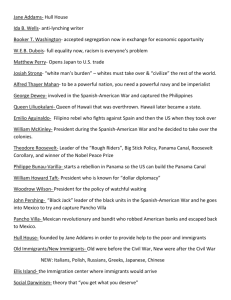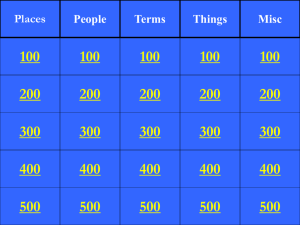Becoming A World Power Chapter 12
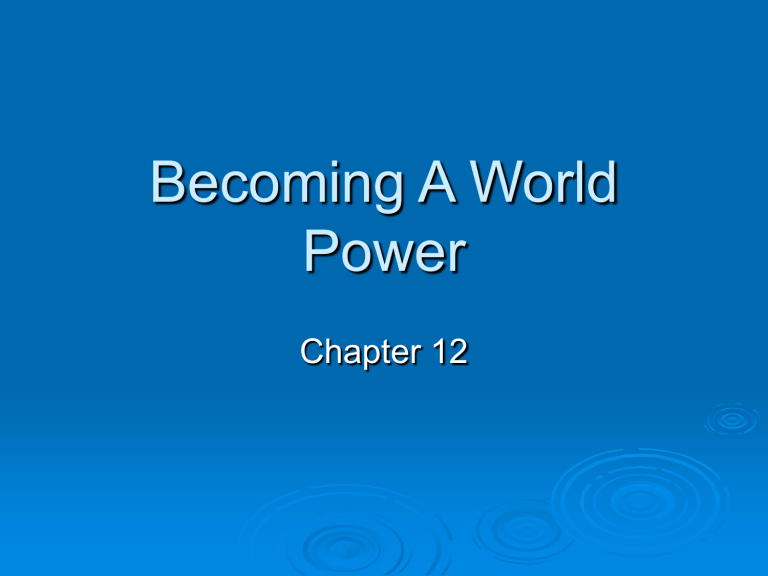
Becoming A World
Power
Chapter 12
The Pressure To Expand
By the late 1800s: Industrialists, inventors, and workers of the U.S. had built a powerful industrial economy
-But, overproduction of food and goods led to financial panic and depression
-Political and business leaders were convinced that the U.S. should establish new markets around the globe
-Also, some believed the U.S. had a responsibility to carry democratic ideas and
Christianity to other nations
The Pressure To Expand
I. Growth of Imperialism
Late 1800s: Marked the peak of European imperialism, with much of Africa and Asia under foreign domination
-Under imperialism , stronger nations attempt to create empires by dominating weaker nations
The Pressure To Expand
Several factors led to the growth of imperialism in the late 1800s.
1) Economic Factors
-The growth of industry in Europe created an increased need for natural resources (rubber, oil, etc.)
-New markets were also needed to sell their goods
The Pressure To Expand
2) Nationalist Factors
-Competition among European nations for large empires was the result of nationalism , or devotion to one’s nation
-Ex: When France acquired land in West
Africa in the late 1800s, rival nations Great
Britain and Germany seized lands nearby to stop French expansion
The Pressure To Expand
3) Military Factors
-Advancements in military technology produced European armies and navies that were far superior to those in Africa and Asia
Also, Europe’s growing navies required naval bases around the world for fuel and supplies
The Pressure To Expand
4) Humanitarian Factors
-Humanitarian and religious goals spurred on the imperialists
-Politicians, doctors, and missionaries believed they had a duty to spread the blessings of
Western civilization, including its law, medicine, and Christian religion
The Pressure To Expand
Improved transportation and communication made it easier for Great
Britain, France, and Russia to expand their empire
“ The sun never sets on the British Empire” became a common slogan
The Pressure To Expand
By 1890: The U.S. was eager to join the competition for new territories
-Supporters of expansion denied that the U.S. sought to annex (join a new territory to an existing country) foreign lands
-However, annexation did take place
The Pressure To Expand
II. The U.S. and Imperialism
In his farewell address in 1796, George
Washington had advised Americans to
“ steer clear of permanent alliances ” with other countries
-The U.S. generally followed that advice for the next 100 years
-Rapid economic growth and the settlement of the West left the U.S. with little interest in foreign affairs
The Pressure To Expand
But, there were a few instances when
Americans “ looked outward ”
1) Alaska
-bought from Russia in 1867 by Secretary of
State William Seward
-Most Americans ridiculed the purchase saying we bought “ walruscovered icebergs” in a
“ barren, worthless, God-forsaken region ”
nicknamed “ Seward’s Folly ”
The Pressure To Expand
2) Pacific Islands
-1853: An American fleet led by Matthew C.
Perry sailed into Tokyo Bay and convinced
Japan to open trade relations with the U.S.
-1860s: U.S. and several European countries had signed treaties that allowed for expanded trade with China
-Now, the U.S. needed refueling stations in the
Pacific for its naval ships
The Pressure To Expand
-1867: Seward annexed the uninhabited
Midway Islands
-1875: U.S. signed a treaty with Hawaii to allow
Hawaiians to sell sugar in the U.S. tax free, as long as they didn’t sell or lease territory to any foreign power
-1893: A group of planters, led by Sanford
Dole, with the help of the U.S. Marines removed Queen Liliuokalani from power
(she had wanted to rid Hawaii of all foreign influence)
The Pressure To Expand
By the 1890s, Americans attitudes toward foreign expansion had changed
-Some argued the U.S. should continue to avoid foreign entanglements
-Others offered a variety of reasons for increased American involvement in the world
The Pressure To Expand
3 Arguments were used in support of American imperialism:
1) Promoting Economic Growth
-Late 1800s: Americans simply could not consume all of the food and other goods that they produced
-Business leaders argued that the economic problems could only be solved by expanding its markets
The Pressure To Expand
-Some business leaders even began to invest directly in the economies of other countries, giving them some political influence
-United Fruit Company eventually dominated the governments of Costa Rica, Guatemala, and
Honduras
-Some referred to the Central American nations as banana republics
The Pressure To Expand
2) Protecting American Security
-Those who supported a strong navy also made a push for expansion
-Alfred T. Mahan in his The Influence of Sea
Power Upon History, 1660-1783 argued that the nation’s economic future hinged on gaining new markets
-Mahan believed the U.S. needed a powerful navy to protect those new markets
The Pressure To Expand
-1883: Congress authorized the building of three cruisers and two battleships, including the
U.S.S. Maine
-Naval Construction Act of 1890 called for more battleships, gunboats, torpedo boats, and cruisers
-By 1900: The U.S. had one of the most powerful navies in the world (modern steampowered, steel-hulled ships)
The Pressure To Expand
3)
Preserving American Spirit
-Some feared the U.S. was losing its strength, energy, and enthusiasm
-People like Frederick Jackson Turner and
Theodore Roosevelt argued that a quest for empire might restore the country’s pioneer spirit
-They also drew on the idea of social
Darwinism (the strong survive) to justify the takeover of new territories
The Pressure To Expand
-Some respected leaders including Josiah
Strong argued that Anglo-Saxon and Teutonic
(Germanic) peoples were superior to the societies they conquered ( Anglo-Saxonism )
-Social Darwinists argued that expansion was not only this nation’s destiny but a noble pursuit as well, for it introduced Christianity and modern civilization to other peoples around the world
The Pressure To Expand
Gradually public opinion warmed up to the idea of expansionism
-Most Americans did not see themselves as potential rulers of oppressed foreign peoples, but they did want new markets abroad
-What they soon discovered was that political and military entanglements tended to follow
The Pressure To Expand
Those in the U.S. who dreamed of expansion looked to three main areas of the world in the late 1800s:
1) Latin America
2) The Islands of the Pacific
3) China
In the process of expanding, the U.S. found itself in conflict with other nations.
The Spanish-American War
The Coming of War
Cuba, a Spanish colony, provided wealth for Spain with sugarcane plantations
1868: Cuban rebels declared independence and began a guerrilla attack against Spanish authorities
-the attack failed …the Cuban rebels fled to the
U.S. to plan a new revolution
The Spanish-American War
Jose Marti – exiled leader of Cuba’s rebellion – fled to NYC
-raised money from Americans and began purchasing weapons and training troops to prepare for an invasion of Cuba
1894: U.S. imposed a new tariff on sugar from Cuba – devastated the Cuban economy
The Spanish-American War
Feb. 1895: Marti and his followers began a new rebellion
-seized control of eastern Cuba, declared its independence
Americans were neutral at the start of the
Cuban revolution
-but, yellow journalists William Randolph Hearst and Joseph Pulitzer ran exaggerated stories of
Spanish attacks on Cubans
The Spanish-American War
The Cuban rebels attacked and destroyed
American property, hoping for American intervention in the war (blamed it on the
Spanish)
Gen. Valeriano Weyler, Spanish governor in Cuba, sent tens of thousands of Cubans to concentration camps where many died
-some Americans called for war against Spain
The Spanish-American War
Enrique Dupuy de Lome – Spanish ambassador to the U.S.
-wrote a private letter which described Pres.
McKinley as “weak”
-printed in The New York Journal (“The de Lome
Letter”)
angered Americans
The Spanish-American War
Feb. 1898: the U.S.S. Maine exploded off the coast of Havana, Cuba
-killed 266 American soldiers
-no one knows why the ship exploded or who did it
-many Americans blamed Spain
“Remember the Maine” became the battle cry across the U.S.
The Spanish-American War
Pres. McKinley did not want to intervene in the war – cost too much money and too many lives
Within McKinley’s own Rep. Party, jingoism (attitude of aggressive nationalism) was strong
April 11, 1898: McKinley asked Congress to authorize the use of force to end the conflict
The Spanish-American War
A War On Two Fronts
U.S. Navy blockaded Cuba
An American fleet in Hong Kong was ordered to attack the Spanish fleet in the
Philippines (a Spanish colony in the
Pacific)
The Spanish-American War
May 1898: Adm. George Dewey led the
U.S. fleet into Manila Bay in the
Philippines
-destroyed or captured Spanish warships
McKinley sent 20,000 American troops to the Philippines
-captured the Spanish-held island of Guam along the way
The Spanish-American War
The American army was untrained and unequipped
-poor conditions in training camps resulted in more Americans dying in training than in battle
The Spanish-American War
June 1898: American troops advanced towards Santiago Harbor in Cuba
among the groups were the “Rough Riders” led by Col. Leonard Wood, with Theodore Roosevelt as second in command
The “Rough Riders” were volunteers – former miners, cowboys, law men, athletes
About 1\4 of all American troops in Cuba were African American
The Spanish-American War
Spanish resistance ended with the surrender of Santiago
Aug. 12, 1898: Spain and the U.S. signed a cease-fire
The Spanish-American War
An American Empire Is Born
Many Americans supported annexing the
Philippines because it would provide…
1) a naval base in Asia
2) stopover on the way to China
3) the ability to teach “less-civilized” peoples
The Spanish-American War
Treaty of Paris (Dec. 1898) – officially ended the Spanish-American War
Cuba became an independent nation
-U.S. acquired Puerto Rico and Guam and paid
Spain $20 million for the Philippines
The treaty made the U.S. an imperial power
The Spanish-American War
Controlling it’s new empire was not easy for the U.S.
Emilio Aguinaldo, a Filipino revolutionary, ordered his troops to attack American soldiers stationed in the Philippines
-Gen. Arthur McArthur was forced to set up concentration camps resulting in 1000s of
Filipino deaths
The Spanish-American War
William Howard Taft, the first U.S. civilian governor of the Philippines, introduced reforms in…
-education
-transportation
-health care
Taft was trying to win over the Filipino people
The Spanish-American War
These reforms slowly lessened Filipino hostility toward American rule
April 1902: all Filipino resistance had stopped
1946: U.S. granted independence to the
Philippines
The Spanish-American War
Foraker Act (1900) – made Puerto Rico an unincorporated territory of the U.S.
1917: Puerto Ricans made citizens of the
U.S.
1947: Puerto Rico given the right to elect its own governor
Current Debate: Should Puerto Rico be granted statehood?
The Spanish-American War
Platt Amendment – ensured that Cuba would remain tied to the U.S.
included a provision which allowed the U.S. to buy or lease naval stations in Cuba
-repealed in 1934
The U.S. In China
1895-1900: American exports to China quadrupled
1894: war between China and Japan began over what is now Korea
-Japan won – showed China was weaker than most thought and Japan had successfully adopted Western tech.
The U.S. In China
Open Door Policy – the belief that all countries should be allowed to trade with
China
-proposed by Sec. of State John Hay
Boxer Rebellion – Chinese nationalists who rebelled against foreign influence
-killed over 200 foreigners (including U.S. missionaries)
The U.S. In China
Great White Fleet – 16 battleships of the new U.S. Navy
-sent around the world to show military strength
Relations between the U.S. and Japan worsened because each wanted to control trade with China
The Panama Canal
U.S. wanted a shorter route between the
Pacific and Atlantic Oceans
A canal built across Central America would make shipping faster
U.S. wanted to build the canal across
Panama – problem: Colombia controlled
Panama and raised the price of the land when the U.S. became interested
The Panama Canal
U.S. supported a revolt against Colombia and Panama became independent
U.S. bought a ten mile wide strip of land from Panama for $10 million
Construction began in 1904 – finished in
1914
Problems for the workers: disease (yellow fever, malaria, etc.) and accidents
-More men died working on the canal than died during the Spanish-American War


